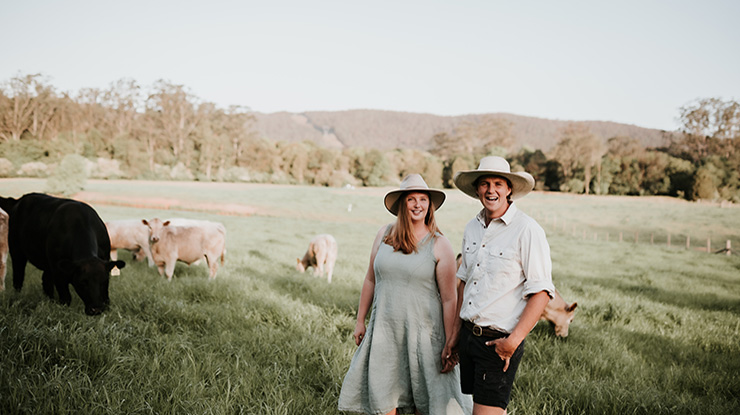 Pictured: Hannah and Tim Eyes
Pictured: Hannah and Tim Eyes
As first generation producers Tim and Hannah Eyes can attest, running a successful, vertically integrated beef business can been done without owning a single hectare – but it takes a bit of creativity and communication to make it work.
Based on NSW’s Central Coast, Tim and Hannah lease seven properties in the region for their beef business ‘The Food Farm’, producing grass fed and finished Angus beef that is processed nearby and then sold direct to consumers online as well as through farmer’s markets in Sydney and Gosford.
According to Tim, the idea for the couple’s ‘farm without a farm’ business model all started when Tim was operating a contracting company in the region.
“I used to have a contracting business, managing and consulting for 36 farms, and that’s where I saw there was underutilised land – in our area, we have mass migration out of the city of people who want to live on the land but don’t ned or want to farm it,” Tim said.
“With its proximity to Sydney, the highly productive land and the high rainfall of 1.2m/year, the potential was endless to be able to produce for the local market without having to own land.
“It’s all about being able to reach scale by leasing land.”
Rising to the challenge
While invaluable when it comes to scaling the business, relying solely on agistment for the businesses’ livestock does come with its challenges.
“With the high turnover of real estate in the area, it can be daunting not having that certainty,” Tim said.
“The personal relationship with agistees can be very rewarding, but managing that relationship can also be one of the challenging parts of leasing for many producers.”
Having agisted land for The Food Farm since 2016, Tim and Hannah have found that being deliberate in their communication with landowners has been the key to their success with agisting land for their herd.
“I think it’s all about having an incredibly open dialogue between the agistee and the agister,” Tom said.
“To facilitate that, it’s really important for communication to be scheduled, so that conversations don’t come and shock you.”
Clear conditions
Setting out clear conditions as part of an agistment agreement – and sticking to those conditions – is also essential to streamlining the management of livestock on agistment.
“It’s all about setting really clear boundaries and expectations,” Tim said.
“You also need to constantly revisit the terms to make sure everyone’s happy.”
“That way, when there’s a problem, everyone at the table’s prepared for it, rather than it being out of the blue.”
Being aware of the temporary nature of agistment and planning accordingly is another crucial step Tim and Hannah take to ensure their business can operate seamlessly.
“Negotiating an exit strategy for both parties is really important – all agreements have come to an end at some point,” Tim said.
“It’s really important for you both to have clear expectations around what the end of the agreement looks like, so it all runs smoothly.”
Farming for the future
While the business continues to grow and succeed in its current state, Tim and Hannah do plan to eventually purchase land of their own as they expand the Food Farm and its operations into the future.
“Telling the red meat industry story is so important to us – and that’s really where farm ownership will become necessary for us,” Tim said.
“We do hope to own a farm to bring people on to truly understand how important cattle and sheep are for the environment, the future of Australia and the future of managing land.”







